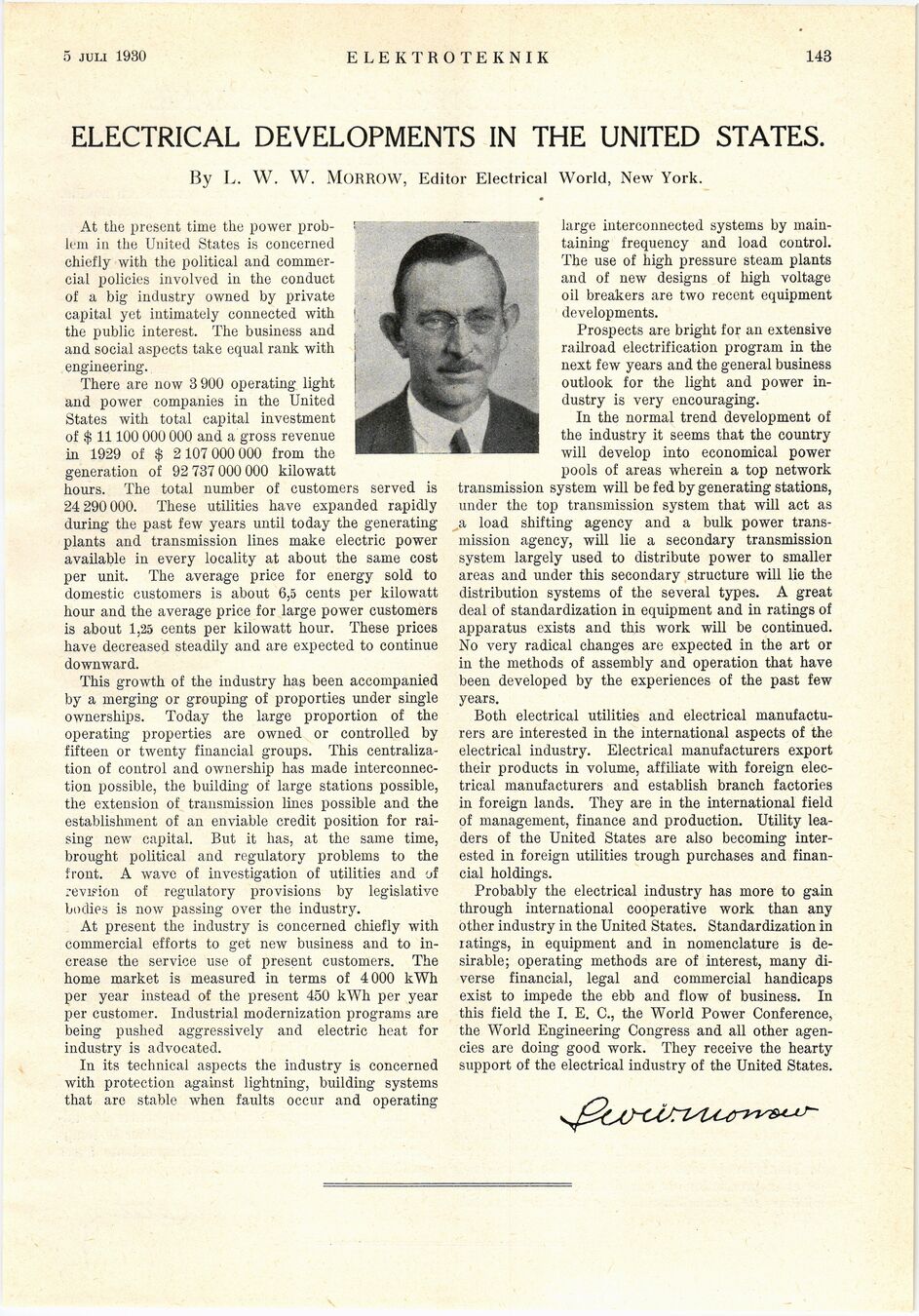
Full resolution (JPEG) - On this page / på denna sida - Sidor ...

<< prev. page << föreg. sida << >> nästa sida >> next page >>
Below is the raw OCR text
from the above scanned image.
Do you see an error? Proofread the page now!
Här nedan syns maskintolkade texten från faksimilbilden ovan.
Ser du något fel? Korrekturläs sidan nu!
This page has never been proofread. / Denna sida har aldrig korrekturlästs.
5 juli 1930
elektroteknik
143
ELECTRICAL DEVELOPMENTS IN THE UNITED STATES.
By L. W. W. Morrow, Editor Electrical World, New York.
At the present time the power
problem in the United States is concerned
chiefly with the political and
commercial policies involved in the conduct
of a big industry owned by private
capital yet intimately connected with
the public interest. The business and
and social aspects take equal rank with
engineering.
There are now 3 900 operating light
and power companies in the United
States with total capital investment
of $ 11 100 000 000 and a gross revenue
in 1929 of $ 2107 000 000 from the
generation of 92 737 000 000 kilowatt
hours. The total number of customers served is
24 290 000. These utilities have expanded rapidly
during the past few years until today the generating
plants and transmission lines make electric power
available in every locality at about the same cost
per unit. The average price for energy sold to
domestic customers is about 6,5 cents per kilowatt
hour and the average price for large power customers
is about 1,25 cents per kilowatt hour. These prices
have decreased steadily and are expected to continue
downward.
This growth of the industry has been accompanied
by a merging or grouping of proporties under single
ownerships. Today the large proportion of the
operating properties are owned or controlled by
fifteen or twenty financial groups. This
centralization of control and ownership has made
interconnection possible, the building of large stations possible,
the extension of transmission lines possible and the
establishment of an enviable credit position for
raising new capital. But it lias, at the same time,
brought political and regulatory problems to the
front. A wave of investigation of utilities and of
revision of regulatory provisions by legislative
bodies is now passing over the industry.
At present the industry is concerned chiefly with
commercial efforts to get new business and to
increase the service use of present customers. The
home market is measured in terms of 4 000 kWh
per year instead of the present 450 kWh per year
per customer. Industrial modernization programs are
being pushed aggressively and electric heat for
industry is advocated.
In its technical aspects the industry is concerned
with protection against lightning, building systems
that are stable when faults occur and operating
large interconnected systems by
maintaining frequency and load control.
The use of high pressure steam plants
and of new designs of high voltage
oil breakers are two recent equipment
developments.
Prospects are bright for an extensive
railroad electrification program in the
next few years and the general business
outlook for the light and power
industry is very encouraging.
In the normal trend development of
the industry it seems that the country
will develop into economical power
pools of areas wherein a top network
transmission system will be fed by generating stations,
under the top transmission system that will act as
a load shifting agency and a bulk power
transmission agency, will lie a secondary transmission
system largely used to distribute power to smaller
areas and under this secondary structure will lie the
distribution systems of the several types. A great
deal of standardization in equipment and in ratings of
apparatus exists and this work will be continued.
No very radical changes are expected in the art or
in the methods of assembly and operation that have
been developed by the experiences of the past few
years.
Both electrical utilities and electrical
manufacturers are interested in the international aspects of the
electrical industry. Electrical manufacturers export
their products in volume, affiliate with foreign
electrical manufacturers and establish branch factories
in foreign lands. They are in the international field
of management, finance and production. Utility
leaders of the United States are also becoming
interested in foreign utilities trough purchases and
financial holdings.
Probably the electrical industry has more to gain
through international cooperative work than any
other industry in the United States. Standardization in
ratings, in equipment and in nomenclature is
desirable; operating methods are of interest, many
diverse financial, legal and commercial handicaps
exist to impede the ebb and flow of business. In
this field the I. E. C., the World Power Conference,
the World Engineering Congress and all other
agencies are doing good work. They receive the hearty
support of the electrical industry of the United States.
<< prev. page << föreg. sida << >> nästa sida >> next page >>